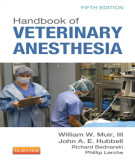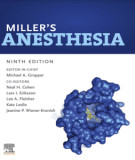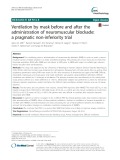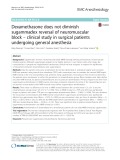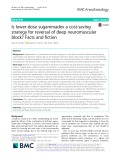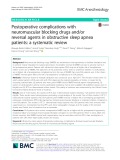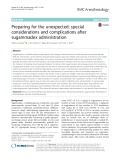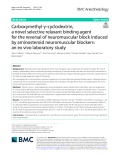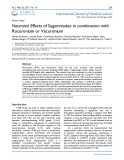
Neuromuscular blocking drugs
-
Part 1 book "Handbook of veterinary anesthesia" includes content: Introduction to anesthesia; animal evaluation and preparation; preanesthetic and perioperative medications; local anesthetic drugs and techniques; local anesthesia in ruminants and pigs; local anesthesia in horses; local anesthesia in dogs and cats; injectable anesthetic drugs; inhalant anesthesia and inhalant anesthetics; neuromuscular blocking drugs,... and other contents.
 317p
317p  oursky10
oursky10
 07-12-2023
07-12-2023
 4
4
 3
3
 Download
Download
-
Part 2 book "Miller's anesthesia" includes content: Pharmacology of neuromuscular blocking drugs; reversal (antagonism) of neuromuscular blockade, local anesthetics; local anesthetics local anesthetics, anesthetic implications of concurrent diseases, anesthetic implications of complementary and alternative therapies.
 1215p
1215p  oursky01
oursky01
 24-07-2023
24-07-2023
 6
6
 2
2
 Download
Download
-
Part 1 book "Basics of anesthesia" includes contents: Scope of anesthesia practice, learning anesthesia, anesthesia and health information technology, basic pharmacologic principles, clinical cardiac and pulmonary physiology, autonomic nervous system, inhaled anesthetics, intravenous anesthetics, local anesthetics, neuromuscular blocking drugs, preoperative evaluation and medication, choice of anesthetic technique, anesthesia delivery systems, airway management, peripheral nerve blocks, patient positioning and associated risks.
 383p
383p  oursky01
oursky01
 17-07-2023
17-07-2023
 8
8
 2
2
 Download
Download
-
Test ventilating prior to administration of neuromuscular blockade (NMB) in order to avoid a cannot intubate-cannot ventilate situation is a classic anesthesia teaching. The primary aim of our study was to show that facemask ventilation (FMV) after NMB was not inferior to FMV prior to NMB with respect to exhaled gas volumes before and after their administration.
 9p
9p  viisaacnewton
viisaacnewton
 25-04-2022
25-04-2022
 10
10
 1
1
 Download
Download
-
Sugammadex reverses neuromuscular block (NMB) through binding aminosteroid neuromuscular blocking agents. Although sugammadex appears to be highly selective, it can interact with other drugs, like corticosteroids. A prospective single-blinded randomized clinical trial was designed to explore the significance of interactions between dexamethasone and sugammadex.
 10p
10p  viottohahn
viottohahn
 30-03-2022
30-03-2022
 10
10
 1
1
 Download
Download
-
Sugammadex, a γ-cyclodextrin derivative, belongs to a new class of selective relaxant binding agents. Sugammadex was approved 10-years ago by the European medicines agency and today is used in clinical anesthesia and emergency medicine globally. In this review, indications for neuromuscular block, the challenge of neuromuscular monitoring and the practice of under-dosing of sugammadex as a potential cost-saving strategy are discussed.
 5p
5p  vampires36
vampires36
 30-12-2021
30-12-2021
 13
13
 2
2
 Download
Download
-
Neuromuscular blocking drugs (NMBD) are administered intra-operatively to facilitate intubation and to achieve muscle relaxation for surgical procedures. Incomplete reversal of NMBD can lead to adverse events in the postoperative period. Patients with obstructive sleep apnea (OSA) may be at higher risk of complications related to the use of NMBD.
 11p
11p  vampires36
vampires36
 30-12-2021
30-12-2021
 12
12
 0
0
 Download
Download
-
In the postoperative period, immediate recovery of muscular power is essential for patient safety, but this can be affected by anaesthetic drugs, opioids and neuromuscular blocking agents (NMBA). In this cohort study, we evaluated anaesthetic and patient-related factors contributing to reduced postoperative muscle power and pulse oximetric saturation.
 9p
9p  vampires36
vampires36
 30-12-2021
30-12-2021
 14
14
 0
0
 Download
Download
-
Sugammadex, a modified gamma-cyclodextrin, has changed clinical practice of neuromuscular reversal dramatically. With the introduction of this selective relaxant binding agent, rapid and reliable neuromuscular reversal from any depth of block became possible.
 8p
8p  vampires36
vampires36
 30-12-2021
30-12-2021
 13
13
 0
0
 Download
Download
-
Residual neuromuscular block at the end of surgery may compromise the patient’s safety. The risk of airway complications can be minimized through monitoring of neuromuscular function and reversal of neuromuscular block if needed. Effective reversal can be achieved with selective relaxant binding agents, however, sugammadex is the only clinically approved drug in this group.
 9p
9p  vidietmarhopp
vidietmarhopp
 28-12-2021
28-12-2021
 7
7
 0
0
 Download
Download
-
Rocuronium (ROC) and Vecuronium (VEC) are the most currently used steroidal non-depolarizing neuromuscular blocking (MNB) agents. Sugammadex (SUG) rapidly reverses steroidal NMB agents after anaesthesia.
 7p
7p  vilusaka2711
vilusaka2711
 19-11-2019
19-11-2019
 10
10
 0
0
 Download
Download
-
(BQ) Part 1 of the document Anesthesiology in clinical (Sixth edition) has contents: Pharmacological principles, inhalation anesthetics, intravenous anesthetics, analgesic agents, neuromuscular blocking agents, anticholinergic drugs, hypotensive agent,... and other contents. Invite you to refer.
 1010p
1010p  thuongdanguyetan06
thuongdanguyetan06
 06-06-2019
06-06-2019
 26
26
 2
2
 Download
Download
-
Acetylcholine is a widespread chemotransmitter in the body, mediating a broad range of physiological effects.There are two distinct classes of receptor for acetylcholine defined on the basis of their preferential activation by the alkaloids, nicotine (from tobacco) and muscarine (from a fungus, Amanita muscaria). Cholinergic drugs (acetylcholine agonists) mimic acetylcholine at all sites although the balance of nicotinic and muscarinic effects is variable.
 15p
15p  bigbaby87
bigbaby87
 03-09-2010
03-09-2010
 61
61
 5
5
 Download
Download
-
The administration of general anaesthetics and neuromuscular blocking drugs is generally confined to trained specialists. Nevertheless, nonspecialists are involved in perioperative care and will benefit from an understanding of how these drugs act. Doctors from a variety of specialties use local anaesthetics and the pharmacology of these drugs is discussed in detail.
 21p
21p  bigbaby87
bigbaby87
 03-09-2010
03-09-2010
 104
104
 13
13
 Download
Download
-
Introduction: Muscle relaxants can be classified into the peripheral-and central-acting drug types ( Table 6.1). The drugs of the peripheral type are also called neuromuscular blocking agents. The peripheralacting muscle relaxants are being used for muscle relaxation upon endotracheal intubation and/or general anaesthesia for surgical operation. The central-acting muscle relaxants are used for treatments of painful muscle contracture caused by locomotorial disorders, and for relaxation of muscle stiffness caused by psychotic tension or by neurosis.
 9p
9p  bigbaby87
bigbaby87
 01-09-2010
01-09-2010
 89
89
 7
7
 Download
Download
CHỦ ĐỀ BẠN MUỐN TÌM








